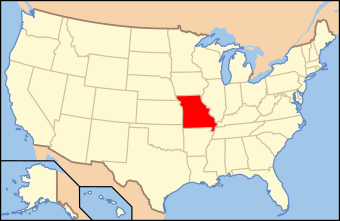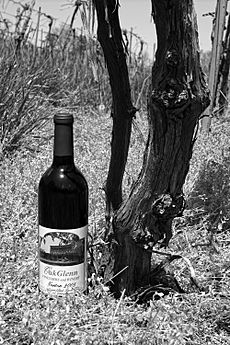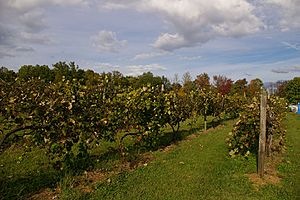Missouri wine facts for kids
| Wine region | |
 |
|
| Official name | State of Missouri |
|---|---|
| Type | U.S. state |
| Year established | 1821 |
| Years of wine industry | 1837-present |
| Country | United States |
| Sub-regions | Augusta AVA, Hermann AVA, Ozark Highlands AVA, Ozark Mountain AVA, Loess Hills District |
| Climate region | Continental/humid subtropical |
| Total area | 69,709 square miles (180,545 km2) |
| No. of vineyards | 400 |
| Grapes produced | Baco noir, Cabernet Franc, Cabernet Sauvignon, Catawba, Cayuga, Chambourcin, Chardonel, Chardonnay, Chelois, Concord, Couderc noir, De Chaunac, Delaware, Diamond, Edelweiss, Malbec, Marechal Foch, Merlot, Muscat Canelli, New York Muscat, Norton, Rayon d'Or, Riesling, Rougeon, Ruby Cabernet, Seyval blanc, St. Vincent, Touriga Francesa, Traminette, Valiant, Vidal blanc, Vignoles, Villard blanc, Villard noir, Vivant, Zinfandel |
| No. of wineries | 134 |
| Wine produced | 971,031 gallons |
Missouri wine is made from grapes grown in the state of Missouri. The wine industry here began in the early 1800s. German immigrants started many vineyards and wineries. This led to the area being called the Missouri "Rhineland". Later, Italian immigrants also joined in.
In the mid-1880s, Missouri made more wine than any other state. Before Prohibition, it was the second-largest wine-producing state. Missouri was also home to the first area recognized as a special grape-growing region. This was the Augusta AVA, approved in 1980. Today, Missouri has four of these special regions. In 2017, there were 125 wineries in the state.
Contents
The History of Missouri Wine
How Wine Making Started
German immigrants came to the Missouri River valley. They started planting vineyards and building wineries. The town of Hermann, Missouri, settled by Germans in 1837, was perfect for growing grapes. By 1848, winemakers there produced 10,000 gallons of wine each year. This grew to 100,000 gallons per year by 1856.
By the 1880s, Missouri produced 2 million gallons of wine annually. This was the most of any state in the nation. Stone Hill Winery in Hermann became the second largest winery in the country. It won awards at world fairs in Vienna (1873) and Philadelphia (1876).
Saving the World's Grapes!
In the mid-1800s, a tiny bug called phylloxera attacked grapevines in Europe. It destroyed most of the Vitis vinifera grape crops, especially in France. Charles Riley, a state insect expert in Missouri, found a solution. He discovered that American grape rootstocks (the underground part of the plant) were resistant to the pest.
Riley helped send millions of these American rootstocks around the world. European grape varieties could then be grafted onto these strong American roots. This saved the French wine industry and others. The city of Montpellier in France even built statues to honor these events. They also honored Riley and his science friend J.É. Planchon.
The Impact of Prohibition
Before Prohibition, Missouri was the second-largest wine-producing state. Prohibition was a time in the United States when making and selling alcohol was illegal. This new law forced almost all wineries to close down. Only one winery, at St. Stanislaus Seminary in Florissant, Missouri, was allowed to make wine for religious purposes. The wine industry in Missouri was destroyed for many decades.
The Return of Wine Making
The wine industry in Missouri started to come back in 1965. Stone Hill Winery in Hermann reopened its doors. Soon after, Mount Pleasant Winery opened in Augusta. Winemakers began to plant new vineyards and open wineries again.
The U.S. government recognized the importance of winemaking. In 1972, a region received the first special certification. This certification is called an American Viticultural Area (AVA). It recognizes areas with unique soil, climate, and other features that make their wines special.
The Augusta AVA
One of these special areas was developed in southwestern St. Charles County, Missouri. This region, the Augusta AVA, was recognized in 1980. It was the very first AVA in the United States!
The Hermann AVA
The Hermann AVA was designated in 1983. It is mostly in Gasconade County, Missouri. This area is on the south side of the Missouri River.
The Ozark Highlands AVA
Italian immigrants also helped start wine production near Rolla, Missouri. This area is now part of the Ozark Highlands AVA. This AVA was designated in 1987. It includes parts of several counties, like Gasconade County, Missouri, Texas County, Missouri, and Dent County, Missouri.
The Ozark Mountain AVA
All three of these smaller AVAs are inside a much larger one. This is the Ozark Mountain AVA. It covers southern Missouri, northwestern Arkansas, and northeastern Oklahoma.
Types of Grapes Grown Here
Missouri's climate is great for growing grapes. It has long, hot summers and plenty of sunshine. The thin, rocky soil of the Ozarks is also good for grapes. The moderate temperatures allow wine to age naturally.
The most famous grape grown in Missouri is Cynthiana/Norton. It is believed to be a type of Vitis aestivalis. Other grapes grown here include native American types like Concord and Catawba. There are also French-American hybrid grapes. These include Vignoles, Seyval, and Chambourcin. Recently, more Vitis vinifera grapes are being planted. These are fine European grapes like Cabernet Franc, Chardonnay, Petit Verdot, and Mourvedre.
The Wine Industry Today
The wine industry in Missouri is growing fast. More than 1,600 acres are planted with grapevines. In 2008, over 888,000 gallons of Missouri wine were sold. By 2009, 97 wineries were making Missouri wines. These wineries were supported by over 400 local vineyards.
By 2016, Missouri had over 126 wineries. Many of these are small, family-run businesses. They are popular places for day trips. The four largest wineries in Missouri are St. James Winery, Stone Hill Winery, Les Bourgeois Winery, and Meramec Vineyards Winery. Missouri also has five wine trails. These trails host events and festivals all year. They encourage people to visit the established wine regions.
A state tax on wine was started in 1984. This tax helps fund the Missouri Wine and Grape Program. This program provides scientific help and marketing support for Missouri wines. The state even hired a grape-growing expert to help restore the industry. Missouri State University works with winemakers to find the best grape varieties for Missouri's climate. The state government wants to help the local wine industry grow. They do this by connecting grape growing with winemaking, restaurants, and tourism.
Missouri State University has its own vineyard called Mountain Grove Cellars. It is part of their Fruit Experimentation Station. The University of Missouri also has a Grape and Wine Institute (GWI). This institute researches the best ways to grow grapes and make wine. They study how this helps the wine industry grow in Missouri and the Midwest.



